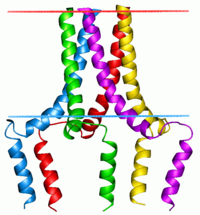Loading AI tools
Mammalian protein found in Homo sapiens From Wikipedia, the free encyclopedia
Phospholamban, also known as PLN or PLB, is a micropeptide protein that in humans is encoded by the PLN gene.[5] Phospholamban is a 52-amino acid integral membrane protein that regulates the calcium (Ca2+) pump in cardiac muscle cells.[6]
 Phospholamban pentamer | |||||||||
| Identifiers | |||||||||
|---|---|---|---|---|---|---|---|---|---|
| Symbol | Phospholamban | ||||||||
| Pfam | PF04272 | ||||||||
| InterPro | IPR005984 | ||||||||
| SCOP2 | 1fjk / SCOPe / SUPFAM | ||||||||
| TCDB | 1.A.50 | ||||||||
| OPM superfamily | 62 | ||||||||
| OPM protein | 1zll | ||||||||
| Membranome | 383 | ||||||||
| |||||||||
This protein is found as a pentamer and is a major substrate for the cAMP-dependent protein kinase (PKA) in cardiac muscle. In the unphosphorylated state, phospholamban is an inhibitor of cardiac muscle sarcoplasmic reticulum Ca2+-ATPase (SERCA2)[7] which transports calcium from cytosol into the sarcoplasmic reticulum. When phosphorylated (by PKA) - disinhibition of Ca2+-ATPase of SR leads to faster Ca2+ uptake into the sarcoplasmic reticulum, thereby contributing to the lusitropic response elicited in heart by beta-agonists.[8] The protein is a key regulator of cardiac diastolic function. Mutations in this gene are a cause of inherited human dilated cardiomyopathy with refractory congestive heart failure.[9]
When phospholamban is phosphorylated by PKA, its ability to inhibit SERCA2 is lost.[10] Thus, activators of PKA, such as the beta-adrenergic agonist epinephrine (released by sympathetic stimulation), may enhance the rate of cardiac myocyte relaxation. In addition, since SERCA2 is more active, the next action potential will cause an increased release of calcium, resulting in increased contraction (positive inotropic effect). When phospholamban is not phosphorylated, such as when PKA is inactive, it can interact with and inhibit SERCA. Thus, the overall effect of unphosphorylated phospholamban is to decrease contractility and the rate of muscle relaxation, thereby decreasing stroke volume and heart rate, respectively.[11]
Gene knockout of phospholamban results in animals with hyperdynamic hearts, with little apparent negative consequence.[12]
Mutations in this gene are a cause of inherited human dilated cardiomyopathy with refractory congestive heart failure.[13][14]
Phospholamban was discovered by Arnold Martin Katz and coworkers in 1974.[15]
PLN has been shown to interact with SLN[16][17] and SERCA1.[17][18][19]
Seamless Wikipedia browsing. On steroids.
Every time you click a link to Wikipedia, Wiktionary or Wikiquote in your browser's search results, it will show the modern Wikiwand interface.
Wikiwand extension is a five stars, simple, with minimum permission required to keep your browsing private, safe and transparent.